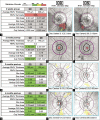Successful management of an intraluminal superior sagittal sinus meningioma causing elevated intracranial pressure using gamma knife radiosurgery in subacute setting: A case report
- PMID: 33767890
- PMCID: PMC7982102
- DOI: 10.25259/SNI_562_2020
Successful management of an intraluminal superior sagittal sinus meningioma causing elevated intracranial pressure using gamma knife radiosurgery in subacute setting: A case report
Abstract
Background: Gamma Knife stereotactic radiosurgery (GKRS) facilitates precisely focused radiation to an intracranial target while minimizing substantial off-target radiation in the surrounding normal tissue. Meningiomas attached to or invading the superior sagittal sinus may result in sinus occlusion and are often impossible to completely resect safely. The authors describe successful management of a patient with a meningioma located completely inside the posterior aspect of the superior sagittal sinus.
Case description: A 46-year-old woman presented to the emergency department with progressive generalized headaches accompanied by worsening vision. The patient underwent a diagnostic brain magnetic resonance imaging which showed a solitary a 7 × 6 × 10 mm homogeneously contrast-enhancing lesion within the lumen of the posterior aspect of superior sagittal sinus without ventricular enlargement or peritumoral edema. The lesion was thought to be a meningioma radiographically. To evaluate the suspected increased intracranial pressure, a lumbar puncture was subsequently performed and demonstrated an opening pressure of 30 cm H2O. After drainage of 40 cc of CSF, the spinal closing pressure was 9 cm H2O. After failure of conservative management with acetazolamide, and determination of surgical inoperability due to the critical intraluminal location of the mass lesion, the patient underwent Gamma Knife radiosurgery. The 0.36 cc tumor was treated as an outpatient in the Perfexion® model Gamma Knife with a highly conformal and selective plan that enclosed the 3D geometry of the tumor with a minimal margin tumor dose of 14 gy at the 50% isodose. Three months after GKRS, the patient reported continued reduction in the frequency and severity of both her headaches and her visual disturbance. Ophthalmological consultation noted progressive resolution of her optic disc edema confirmed by formal optical coherence tomography. The patient is now 3 years out from GKRS with complete resolution of headache symptoms along with persistent reduction in tumor size (3 × 1 × 4 mm) on serial period imaging and resolution of papilledema.
Conclusion: Tumors located in such critical anatomic regions, as in our patient, should be considered for primary GKRS when the risks of biopsy or removal are too high. GKRS was able to provide great radiographic and clinical result in an intricately located meningioma.
Keywords: Gamma Knife radiosurgery; Image-guided neurosurgery; Lesion; Radiosurgery; Stereotactic surgery.
Copyright: © 2021 Surgical Neurology International.
Conflict of interest statement
There are no conflicts of interest.
Figures



Similar articles
-
Gamma Knife radiosurgery for intracranial benign meningiomas: follow-up outcome in 130 patients.Neurosurg Focus. 2019 Jun 1;46(6):E7. doi: 10.3171/2019.3.FOCUS1956. Neurosurg Focus. 2019. PMID: 31153153
-
Analysis of the results of recurrent intracranial meningiomas treated with re-radiosurgery.Clin Neurol Neurosurg. 2017 Feb;153:93-101. doi: 10.1016/j.clineuro.2016.12.014. Epub 2016 Dec 29. Clin Neurol Neurosurg. 2017. PMID: 28081463
-
Gamma Knife radiosurgery in the treatment of abducens nerve schwannomas: a retrospective study.J Neurosurg. 2016 Oct;125(4):832-837. doi: 10.3171/2015.8.JNS151140. Epub 2016 Jan 29. J Neurosurg. 2016. PMID: 26824380
-
Radiosurgery and fractionated radiotherapy for cavernous sinus meningioma: a systematic review and meta-analysis.Acta Neurochir (Wien). 2018 Dec;160(12):2367-2378. doi: 10.1007/s00701-018-3711-9. Epub 2018 Nov 5. Acta Neurochir (Wien). 2018. PMID: 30393820
-
Efficacy and safety of gamma knife radiosurgery for posterior cranial fossa meningioma: a systematic review.Neurosurg Rev. 2020 Aug;43(4):1089-1099. doi: 10.1007/s10143-019-01144-x. Epub 2019 Aug 5. Neurosurg Rev. 2020. PMID: 31385110
References
-
- Azar M, Kazemi F, Jahanbakhshi A, Chanideh I, Jalessi M, Amini E, et al. Gamma knife radiosurgery for cavernous sinus meningiomas: Analysis of outcome in 166 patients. Stereotact Funct Neurosurg. 2017;95:259–67. - PubMed
-
- Bonnal J, Brotchi J. Surgery of the superior sagittal sinus in parasagittal meningiomas. J Neurosurg. 1978;48:935–45. - PubMed
-
- Conti A, Pontoriero A, Salamone I, Siragusa C, Midili F, La Torre D, et al. Protecting venous structures during radiosurgery for parasagittal meningiomas. Neurosurg Focus. 2009;27:E11. - PubMed
-
- Davidson L, Fishback D, Russin JJ, Weiss MH, Yu C, Pagnini PG, et al. Postoperative Gamma Knife surgery for benign meningiomas of the cranial base. Neurosurg Focus. 2007;23:E6. - PubMed
-
- DiMeco F, Li KW, Casali C, Ciceri E, Giombini S, Filippini G, et al. Meningiomas invading the superior sagittal sinus: Surgical experience in 108 cases. Neurosurgery. 2008;62(6) Suppl 3:1124–35. - PubMed
Publication types
LinkOut - more resources
Full Text Sources
Other Literature Sources
